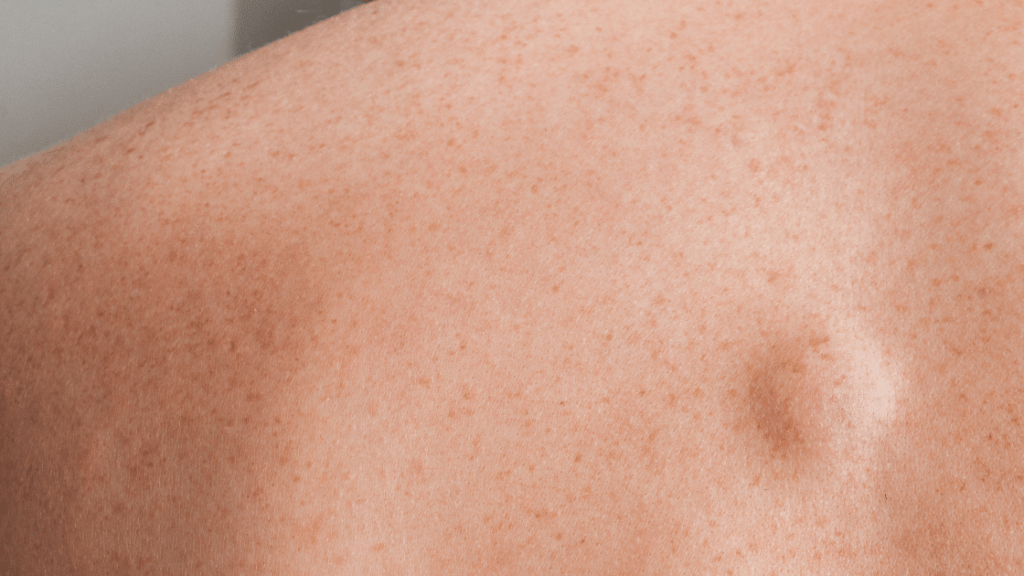What is a Lipoma?

Lipomas are fatty deposits that grow in soft body tissues. They are the most common soft body tissue tumor, and they usually develop in adults between ages 40 and 60.
Don’t let word tumor scare you, though. These slow-growing lumps are almost always benign and painless.
As a massage therapist, I encounter lipomas often. While they can occur in any area where soft tissue is present, I most often find them on my patients’ necks, shoulders, arms, backs, and thighs. The size and number of lipomas varies from person to person, with some being as small as a pea and others being the size of a chicken’s egg. Sometimes, they can grow as large as a softball (or bigger!) but I’ve yet to see one firsthand. The biggest lipoma ever, documented in 1894 and belonging to an unfortunate 26-year-old man, weighed just over 50 pounds!
Ok, that’s enough trivia for now. This article is for my many patients who ask questions regarding their lipomas. I hope this provides the answers you’ve all been looking for!
Lipoma Symptoms
Other than the presence of the benign cysts themselves, lipomas aren’t usually symptomatic. Depending on the location of the lump, however, one of the following symptoms may occur:
Pain
- A lipoma can cause pain if it compresses nerves. Nerve pain occurs in less than 5% of lipomas.
- Joint pain can also occur if the lipoma is situated too close to the joint. This commonly takes place near the knees.
- Though rare, some lumps contain more blood vessels than the average lipoma. Those packed with blood vessels are called angiolipomas, and they tend to be firm and painful.
Nausea and Digestive Issues
- Some lipomas press down into internal organs. If one should impact the bowels, nausea, vomiting, or constipation may occur.
Risk Factors
While the exact cause is still unknown, there are factors that play a role in the likelihood of developing lipomas.
- Genetics – Lipomas tend to run in families. If you have a family member with lipomas, your risk increases.
- Age – As mentioned earlier, the onset usually takes place between ages 40 and 60. However, they can occur at any age.
- Injury – Research shows that lipomas may develop in soft tissue areas that have endured traumatic injuries.
- Weight – Obesity increases the risk of diabetes and high cholesterol, both of which are often present with the onset of lipomas.
- Illness – Lipomas are common in those diagnosed with adiposis dolorosa, Cowden syndrome, Madelung disease, and Gardner’s syndrome.
When to See a Doctor
After your lipoma diagnosis, you most likely won’t need treatment or a prompt follow-up appointment. But that doesn’t mean you should just ignore the lipomas. Call your doctor if you notice any of the following:
- Rapid Growth – Lipomas generally grow slowly. As is the case with any skin issue – moles, lesions, rashes, etc. – a sudden increase in size should be addressed immediately.
- Increased Pain – If any pain is present, it should only be mild. Ask your doctor about pain relief options.
- Inflammation – Again, you don’t need to be in pain. Seek treatment if the lipoma reddens, burns, or itches.
- Change in Texture – Lipomas are usually soft and moveable. A hard and immovable lipoma is likely to become painful and tender to the touch.
Keep in mind that the symptoms above are unlikely to cause serious issues. An irritated lipoma might just need a steroid shot to relax. And should the lipoma be sizable or excruciating, removal is relatively quick and easy. Lipomas can be done away with through liposuction or surgical excision. You’ll be under anesthesia and go home the same day, regardless of which removal procedure you choose.
Now You Know!
In most cases, lipomas are no cause for concern. And if they ever become one, treatment is accessible and low risk.
As always, stay happy and healthy!

Katrina Jenkins
Author, Licensed Massage Therapist
Katrina Jenkins graduated from Towson University in 2013 with a Bachelor’s Degree in Health Science and worked as a nurse’s aide briefly before pursuing her true passion. She graduated from the Massage Therapy Institute of Colorado in April 2016 with honors and completed the Touch of Healers Scholarship Program the following summer. She has been a part of the Moyer Total Wellness Team since the summer of 2017.
Resources
Charifa, A., Azmat, C.E. and Badri, T. (2020). Lipomas, Pathology. [online] PubMed. Available at: https://www.ncbi.nlm.nih.gov/books/NBK482343/.
Nall, MSN, CRNA, R. (2018). Angiolipoma: Definition, causes, and treatment. [online] www.medicalnewstoday.com. Available at: https://www.medicalnewstoday.com/articles/321824.
Ricci, J.A. (2018). Untreated for 20 Years: A 14 Kilogram Subcutaneous Lipoma. World Journal of Plastic Surgery, [online] 7(3), pp.368–371. Available at: https://www.ncbi.nlm.nih.gov/pmc/articles/PMC6290305/.
Silva, J.C. (2020). Lipoma: Causes, symptoms, diagnosis, and removal. [online] www.medicalnewstoday.com. Available at: https://www.medicalnewstoday.com/articles/322551#symptoms.
Photo Credit
Canva by Cristian Storto Fotografia
